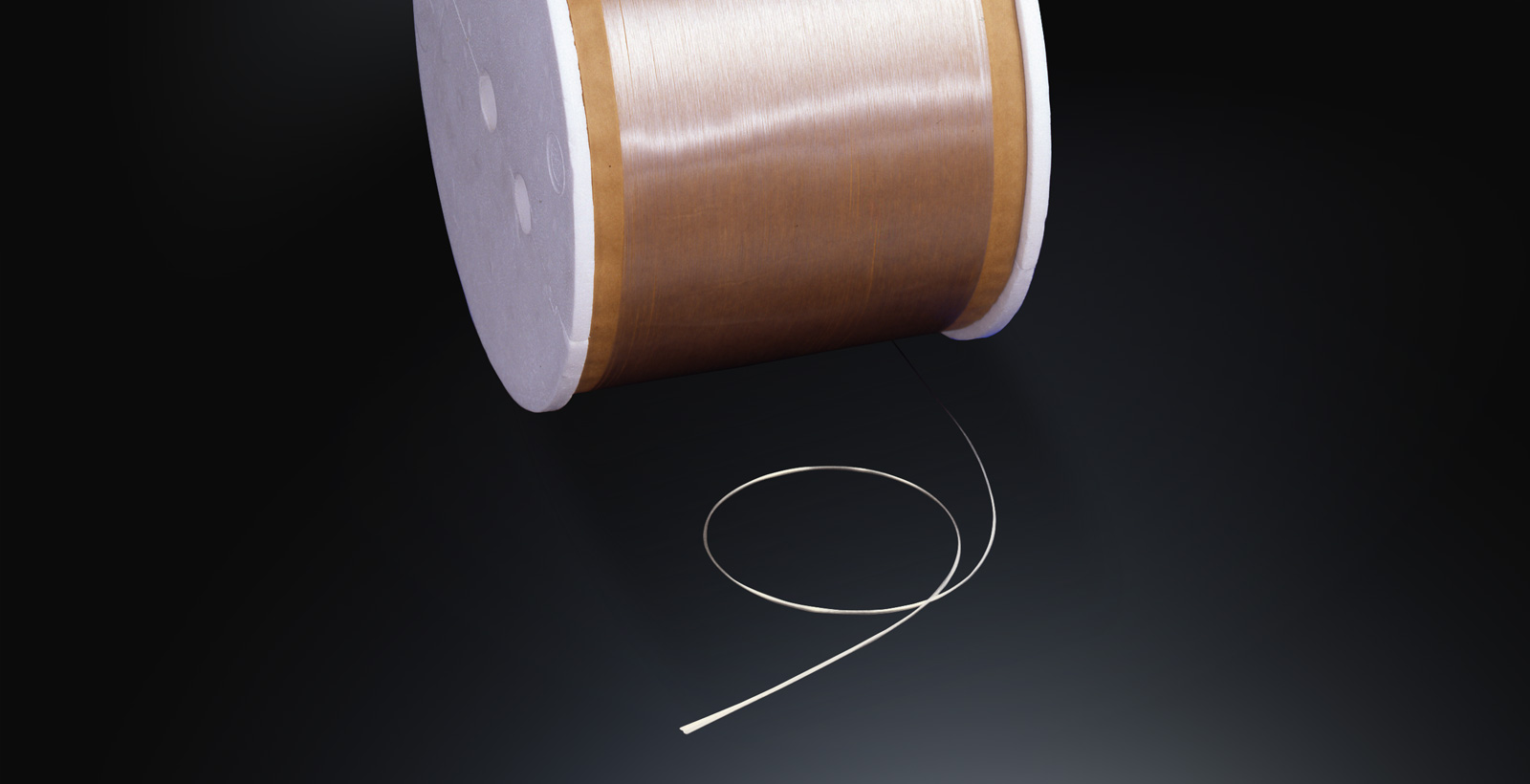
Bare Optical Fiber Lineup
Sumita offers a wide selection of the highest quality raw optical fibers with a variety of opening angles covering the spectrum UV, VIS and NIR wavelengths to help you with your requirements and environments.
Optical Fiber Lineup
| Wavelength | Material | Type of Optical Fiber | Numerical Aperture (NA) | Opening angle(2θ) |
|---|---|---|---|---|
| Visible | Multi-component glass | SOG-120C* | 0.86 | 119° |
| SOG-100 | 0.77 | 100° | ||
| SOG-80S | 0.63 | 79° | ||
| SOG-70S | 0.57 | 70° | ||
| SOG-35C* | 0.31 | 35° | ||
| SOG-15 | 0.14 | 16° | ||
| NIR (Near IR) | SOG-70SIR | 0.57 | 70° | |
| UV | ST365-35 | 0.32 | 38° |
* SOG-35C and SOG-120C have improved transmittance in short wavelength compared to the previous models SOG-35 and SOG-120S respectively.
-
Transmittance
-
Visible
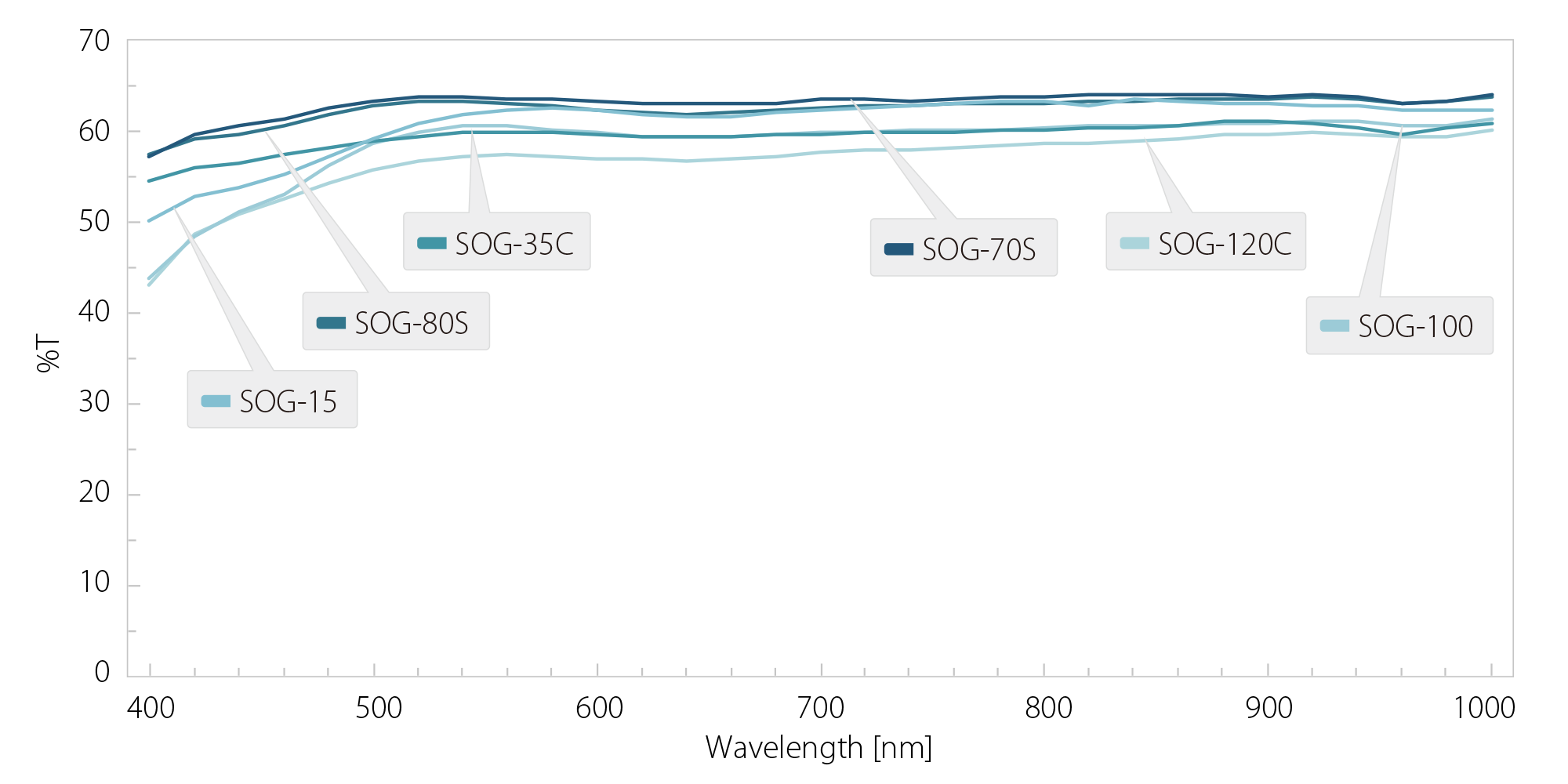
- Measurement conditions
- ・ SOG-15, SOG-35C, SOG-70S, SOG-80S, SOG-100, SOG-120C :
Light guide bundle with 5 mm diameter (Single fiber diameter: 50μm)
-
NIR (Near IR)
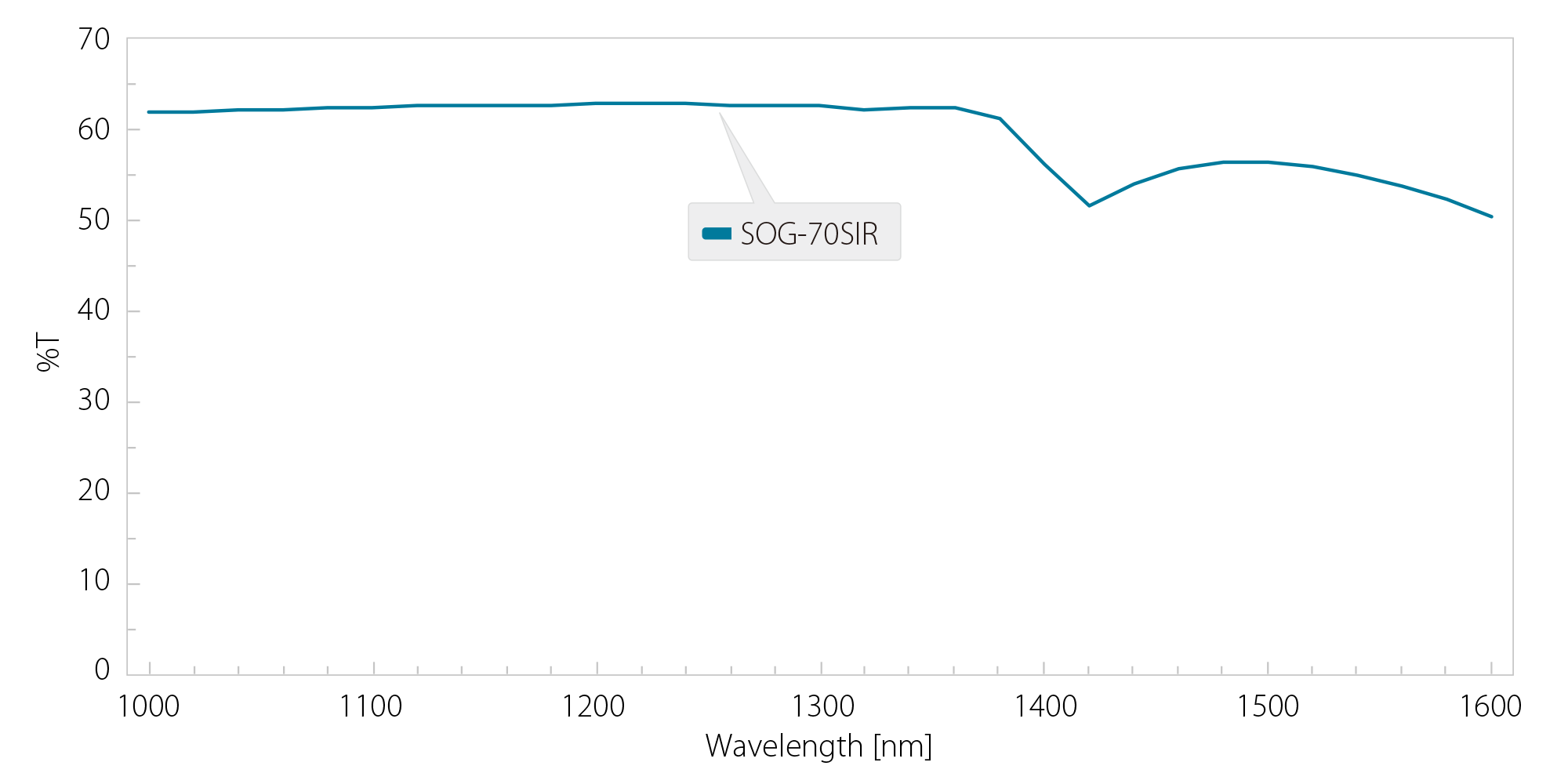
- Measurement conditions
- Light guide bundle with 5 mm diameter (Single fiber diameter: 50μm)
-
UV
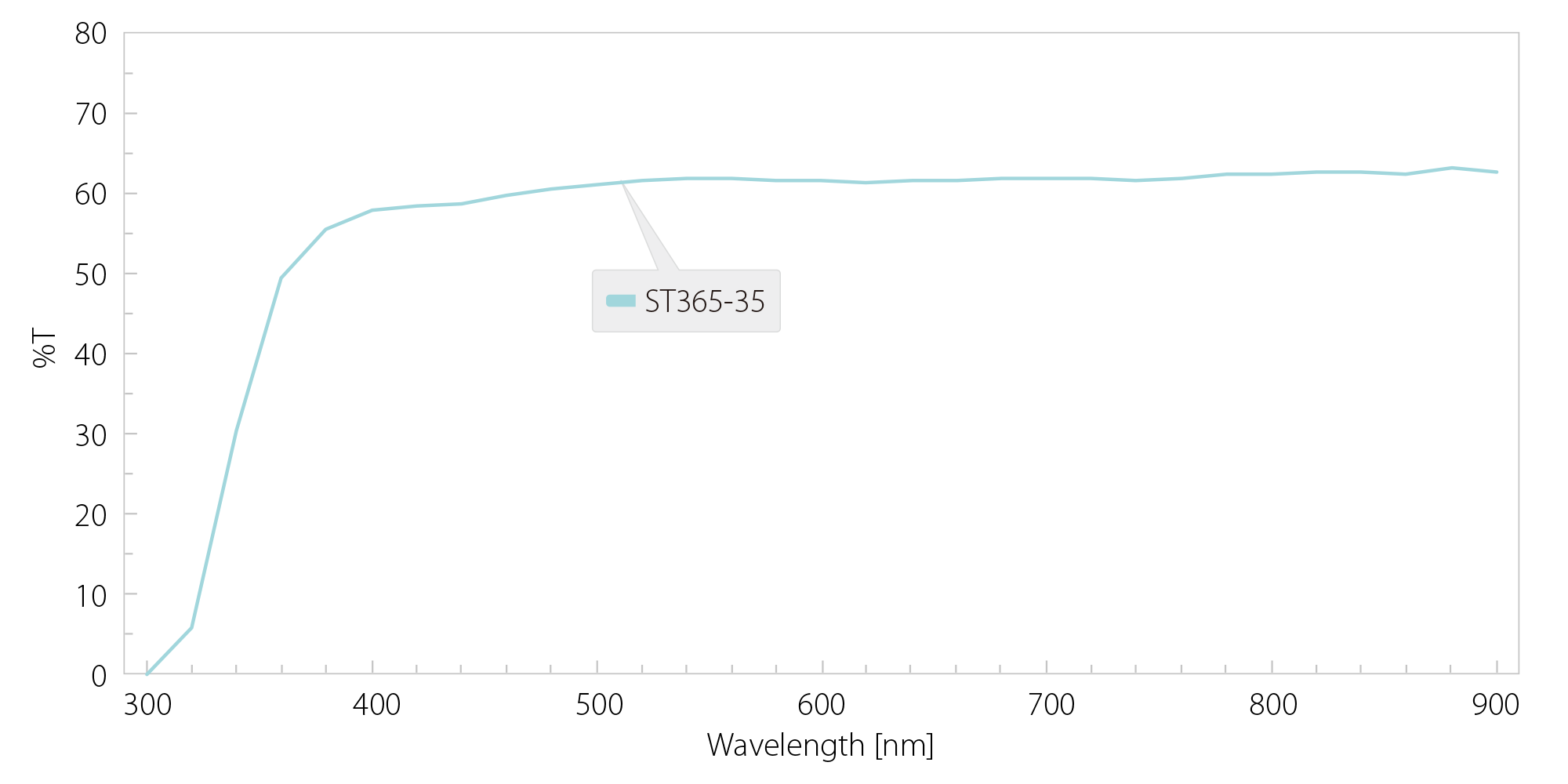
- Measurement conditions
- Light guide bundle with 4 mm diameter x L 1 m
*ST365-35 (Single fiber diameter: 50μm)
-
-
SOG-120C
SOG-120C multi-component glass optical fibers have a wide opening angle of 119 degrees. Using in combination with a wide-angle light source allows for illuminating a large area in a short working distance.
RoHS compliant. Free of harmful substances like lead and arsenic. Suitable for medical applications including endoscopy light guides.Technical Data
Type of Optical Fiber A multimode/step index optical fiber Numerical Aperture 0.86 @587nm Opening Angle 119° @587nm Optical Attenuation
(Reference value)2.00 dB/m @400nm
0.50 dB/m @550nmSingle Fiber Diameter 30μm, 50μm ±3μm Core:115µm
Cladding:125µm
Coating: 150µm*1Heat Resistance <200℃ <80℃ Chemical Resistance*2 Core Glass Cladding Glass Acid Resistance 4 2 Water Resistance 1 2 - *1:Minimum bending radius(Reference value):R10mm
Tensile strength (Φ125µm , Reference value):2kg - *2:Class according to JOGIS (Japanese Optical Glass Industrial Standard)
-
Transmittance

- Measurement conditions
- Light guide bundle with 5 mm diameter (Single fiber diameter: 50μm)
-
Solarization Stability
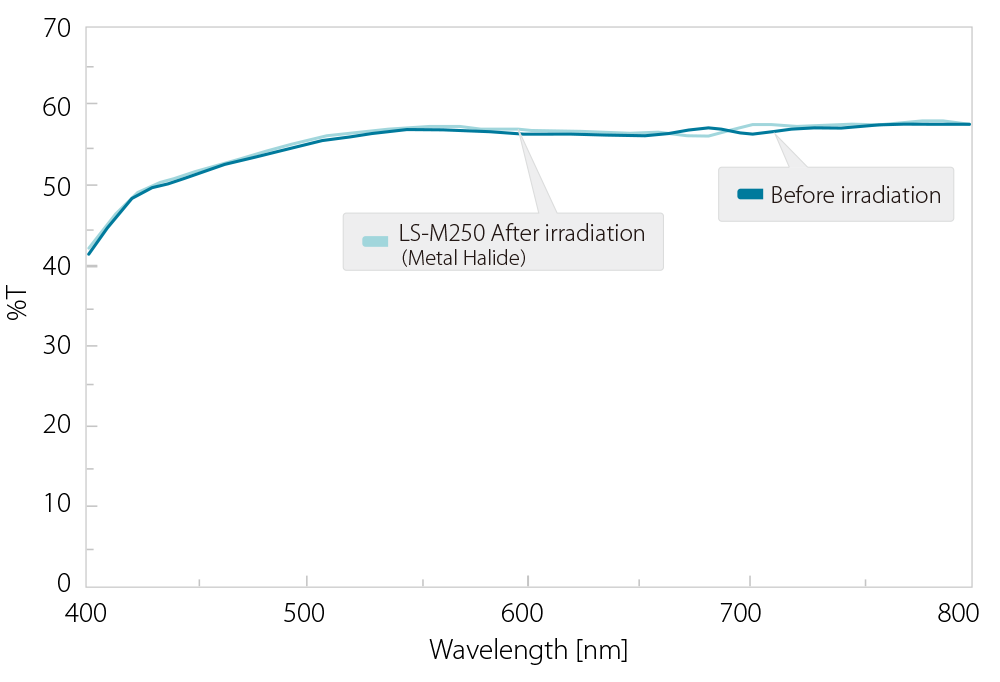
- Measurement conditions
- A light guide bundle with 5 mm diameter of 1 m length is exposed to Metal Halide Lamp (400 nm Cut Longpass Filter) for 100 hours.
-
Wavelength Dependence of Opening Angle (calculated from the refractive index)
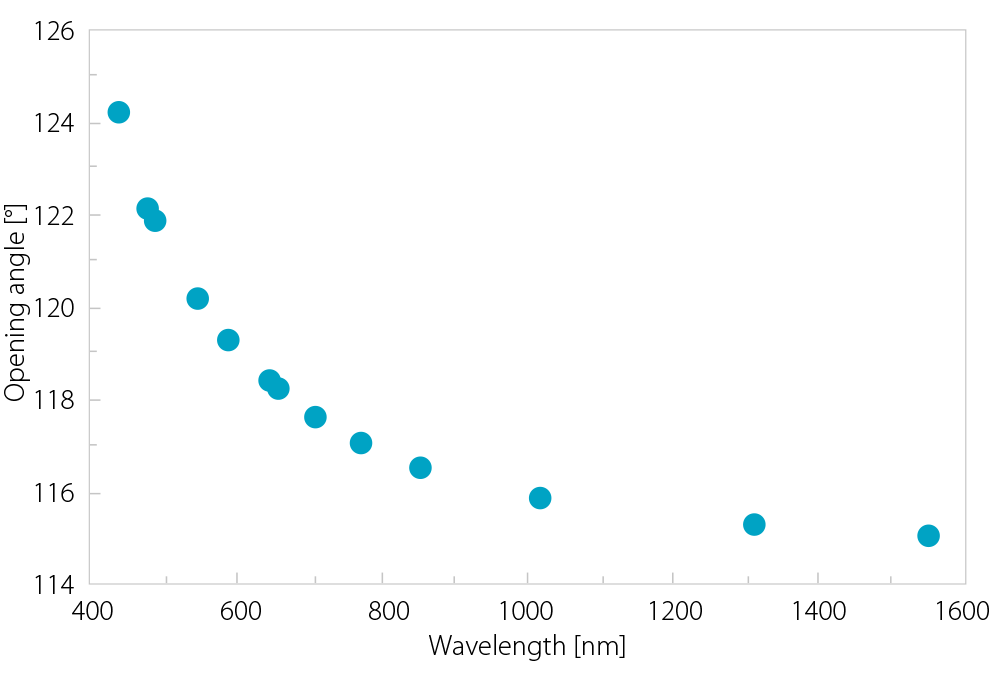
- Measurement conditions
- The opening angle varies with wavelength, depending on the wavelength dispersion of the core and cladding glass materials. In the plot above, the opening angle calculated from the refractive indices of the core and cladding glass materials is plotted for each wavelength.
Downloads - *1:Minimum bending radius(Reference value):R10mm
-
SOG-100
Having a wider opening angle than the standard multi-component glass optical fibers, SOG-100 fibers receive light and illuminates at a relatively wider angle. Suitable for a wide-range illumination.
RoHS compliant. Free of harmful substances like lead and arsenic. Suitable for medical applications.Technical Data
Fiber Type A multimode/step index optical fiber Numerical Aperture 0.77 @587nm Opening angle 100° @587nm Optical Attenuation
(Reference value)1.50 dB/m @400nm
0.35 dB/m @550nmHeat Resistance < 200℃ Single Fiber Diameter 30μm, 50μm ±3μm Chemical Resistance Core Glass Cladding Glass Acid Resistance 4 1 Water Resistance 1 1 Class according to JOGIS (Japanese Optical Glass Industrial Standard)
-
Transmittance

- Measurement conditions
- Light guide bundle with 5 mm diameter (Single fiber diameter: 50μm)
-
Solarization Stability

- Measurement conditions
- Light guide bundles with 5 mm diameter of 1 m length are exposed to several light sources for 300 hours.
Light sources: Halogen, Metal halide, White LED
-
Wavelength dependence of opening angle (calculated from the refractive index)

- Measurement conditions
- The opening angle varies with wavelength, depending on the wavelength dispersion of the core and cladding glass materials. In the plot above, the opening angle calculated from the refractive indices of the core and cladding glass materials is plotted for each wavelength.
Downloads -
-
SOG-80S
SOG-80S multi-component glass fibers have a wide opening angle and excellent color rendering. With a wide opening angle of approximately 80 degrees, the SOG-80S has low transmission loss in wavelengths from 400 nm to 1000 nm and illuminates a wide range of light from a light source with excellent color rendering.
RoHS compliant. Free of harmful substances like lead and arsenic. Suitable for medical application.Technical Data
Fiber Type A multimode/step index optical fiber Numerical Aperture 0.63 @587nm Opening angle 79° @587nm Optical Attenuation
(Reference value)0.70 dB/m @400nm
0.25 dB/m @650nmHeat Resistance < 200℃ Single Fiber Diameter 30μm, 50μm ±3μm Chemical Resistance Core Glass Cladding Glass Acid Resistance 4 1 Water Resistance 1 1 Class according to JOGIS (Japanese Optical Glass Industrial Standard)
-
Transmittance

- Measurement conditions
- Light guide bundle with 5 mm diameter (Single fiber diameter: 50μm)
-
Solarization Stability

- Measurement conditions
- Light guide bundles with 5 mm diameter of 1 m length are exposed to several light sources for 300 hours.
Light sources: Halogen, Metal halide, White LED
-
Wavelength dependence of opening angle (calculated from the refractive index)

- Measurement conditions
- The opening angle varies with wavelength, depending on the wavelength dispersion of the core and cladding glass materials. In the plot above, the opening angle calculated from the refractive indices of the core and cladding glass materials is plotted for each wavelength.
Downloads -
-
SOG-70S
SOG-70S multi-component glass fibers have excellent color rendering and transmittance from 400 nm to 1000 nm. The SOG-70S fiber is thermally stable. Heat-fused light guides using SOG-70S are also available.
RoHS compliant. Free of harmful substances like lead and arsenic. Suitable for medical application.Technical Data
Fiber Type A multimode/step index optical fiber Numerical Aperture 0.57 @587nm Opening angle 70° @587nm Optical Attenuation
(Reference value)0.70 dB/m @400nm
0.25 dB/m @650nmHeat Resistance < 200℃ Single Fiber Diameter 30μm, 50μm ±3μm Chemical Resistance Core Glass Cladding Glass Acid Resistance 3 1 Water Resistance 1 1 Class according to JOGIS (Japanese Optical Glass Industrial Standard)
-
Transmittance

- Measurement conditions
- Light guide bundle with 5 mm diameter (Single fiber diameter: 50μm)
-
Solarization Stability

- Measurement conditions
- Light guide bundles with 5 mm diameter of 1 m length are exposed to several light sources for 300 hours.
Light sources: Halogen, Metal halide, White LED
-
Wavelength dependence of opening angle (calculated from the refractive index)

- Measurement conditions
- The opening angle varies with wavelength, depending on the wavelength dispersion of the core and cladding glass materials. In the plot above, the opening angle calculated from the refractive indices of the core and cladding glass materials is plotted for each wavelength.
Downloads -
-
SOG-35C
Having a similar NA to the silica fiber, SOG-35C multi-component glass optical fibers have a narrow opening angle and project light into a tight area. Optimum for directional lighting, optical sensors, and illumination for small areas.
RoHS compliant. Free of harmful substances like lead and arsenic. Suitable for medical application.Technical Data
Fiber Type A multimode/step index optical fiber Numerical Aperture 0.31 @587nm Opening angle 35° @587nm Optical Attenuation
(Reference value)0.60 dB/m @400nm
0.35 dB/m @550nmHeat Resistance < 200℃ Single Fiber Diameter 30μm, 50μm ±3μm Chemical Resistance Core Glass Cladding Glass Acid Resistance 2 2 Water Resistance 1 1 Class according to JOGIS (Japanese Optical Glass Industrial Standard)
-
Transmittance

- Measurement conditions
- Light guide bundle with 5 mm diameter (Single fiber diameter: 50μm)
-
Solarization Stability

- Measurement conditions
- A light guide bundle with 5 mm diameter of 1 m length is exposed to Metal Halide Lamp (400 nm Cut Longpass Filter) for 100 hours.
-
Wavelength dependence of opening angle (calculated from the refractive index)

- Measurement conditions
- The opening angle varies with wavelength, depending on the wavelength dispersion of the core and cladding glass materials. In the plot above, the opening angle calculated from the refractive indices of the core and cladding glass materials is plotted for each wavelength.
Downloads -
-
SOG-15
SOG-15 multi-component glass optical fibers have a lower NA than silica optical fibers. Ideal for lighting a specified area precisely (e.g. optical sensors).
RoHS compliant. Free of harmful substances like lead and arsenic. Suitable for medical application.Technical Data
Fiber Type A multimode/step index optical fiber Numerical Aperture 0.14 @587nm Opening angle 16° @587nm Optical Attenuation
(Reference value)1.50 dB/m @400nm
0.50 dB/m @550nmHeat Resistance < 200℃ Single Fiber Diameter 30μm, 50μm ±3μm Chemical Resistance Core Glass Cladding Glass Acid Resistance 1 1 Water Resistance 2 2 Class according to JOGIS (Japanese Optical Glass Industrial Standard)
-
Transmittance

- Measurement conditions
- Light guide bundle with 5 mm diameter (Single fiber diameter: 50μm)
-
Solarization Stability

- Measurement conditions
- Light guide bundles with 5 mm diameter of 1 m length are exposed to several light sources for 300 hours.
Light sources: Halogen, Metal halide, White LED
-
Wavelength dependence of opening angle (calculated from the refractive index)

- Measurement conditions
- The opening angle varies with wavelength, depending on the wavelength dispersion of the core and cladding glass materials. In the plot above, the opening angle calculated from the refractive indices of the core and cladding glass materials is plotted for each wavelength.
Downloads -
-
SOG-70SIR
SOG-70SIR multi-component glass optical fibers are excellent in transmission from 1100 nm to 1350 nm. The SOG-70SIR fiber has low OH absorption, especially at 1420 nm, and low transmission loss in NIR. Since the fiber transmits well in NIR, it is widely used for heat-related power transmission and sensors.
RoHS compliant. Free of harmful substances like lead and arsenic. Suitable for medical application.Technical Data
Fiber Type A multimode/step index optical fiber Numerical Aperture 0.57 @587nm Opening angle 70° @587nm Optical Attenuation
(Reference value)1.20 dB/m @1,430nm Heat Resistance < 200℃ Single Fiber Diameter 50μm ±3μm Chemical Resistance Core Glass Cladding Glass Acid Resistance 2 1 Water Resistance 1 1 Class according to JOGIS (Japanese Optical Glass Industrial Standard)
-
Transmittance

- Measurement conditions
- Light guide bundle with 5 mm diameter (Single fiber diameter: 50μm)
-
Solarization Stability

- Measurement conditions
- Light guide bundles with 5 mm diameter of 1 m length are exposed to several light sources for 300 hours.
Light sources: Halogen, Metal halide, White LED
-
Wavelength dependence of opening angle (calculated from the refractive index)

- Measurement conditions
- The opening angle varies with wavelength, depending on the wavelength dispersion of the core and cladding glass materials. In the plot above, the opening angle calculated from the refractive indices of the core and cladding glass materials is plotted for each wavelength.
Downloads -
-
ST365-35
ST365-35 multi-component glass fibers can be used at 365 nm and above (UVA- Vis). Compared to typical silica fibers, ST356-35 fibers are thin and highly flexible, allowing the fiber bundles to be assembled in complex shapes and randomized. The ST365-35 boasts high NA, enabling efficient light collection.
RoHS compliant. Free of harmful substances like lead and arsenic. Suitable for medical application.
Note: ST365-35 fibers may exhibit solarization depending on the wavelength and intensity of a light source, the operating temperature, etc.Technical Data
Fiber Type A multimode/step index optical fiber Numerical Aperture 0.32 @587nm Opening angle 38° @587nm Optical Attenuation
(Reference value)1.00 dB/m @365nm Heat Resistance < 200℃ Single Fiber Diameter 30μm, 50μm ±3μm Chemical Resistance Core Glass Cladding Glass Acid Resistance 4 2 Water Resistance 3 2 Class according to JOGIS (Japanese Optical Glass Industrial Standard)
-
Transmittance

- Measurement conditions
- Light guide bundle with 5 mm diameter (Single fiber diameter: 50μm)
-
Solarization Stability

- Measurement conditions
- A light guide bundle with 5 mm diameter of 1 m length is exposed to Metal Halide Lamp (400 nm Cut Longpass Filter) for 100 hours.
Note: ST365-35 fibers may exhibit solarization depending on the wavelength and intensity of a light source, the operating temperature, etc.
-
Wavelength dependence of opening angle (calculated from the refractive index)

- Measurement conditions
- The opening angle varies with wavelength, depending on the wavelength dispersion of the core and cladding glass materials. In the plot above, the opening angle calculated from the refractive indices of the core and cladding glass materials is plotted for each wavelength.
Downloads -